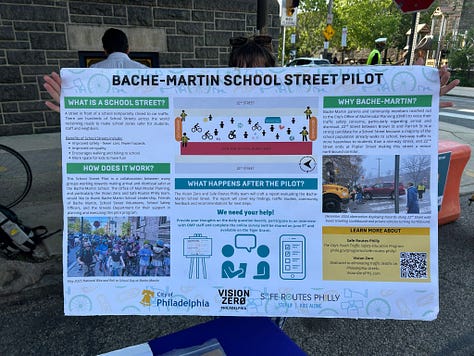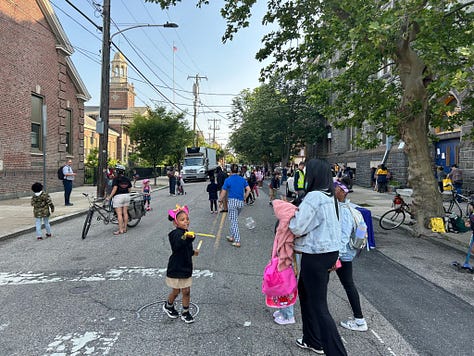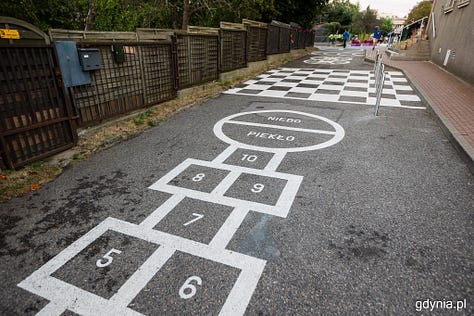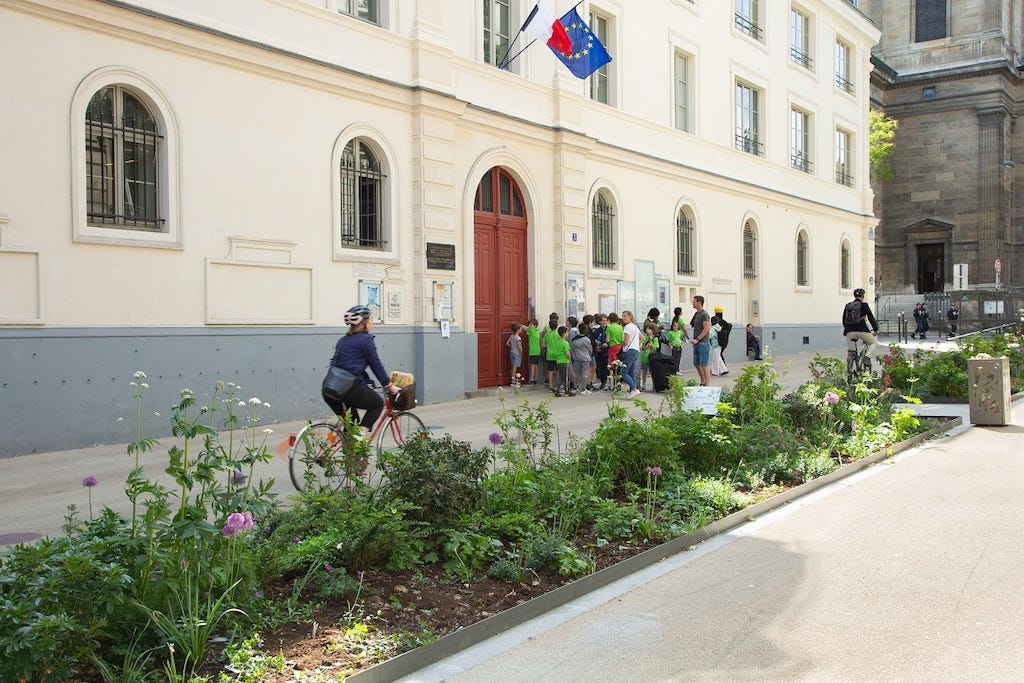How Philly Launched Its First School Street Pilot
An amazing first step toward safer streets for kids
Hi readers, I published this piece about a Philadelphia school street pilot before any local media did. Kinda cool, right? I really, truly can only write this newsletter as long as I reach a critical mass of paid subscribers. That means I need a few people to sign up with each post. Usually I put a paywall halfway into a piece to trigger subscriptions, but I wanted to make this piece free in the hopes it’s helpful to other people trying to get a school street together. If you’ve been reading and enjoying this newsletter awhile, please take a minute and become a paying subscriber. Thank you to everyone who has already upgraded to paid!
I have email chains about my kids’ public school’s street safety that go back years. Parents at our local public school, Bache-Martin, were concerned about letting their kids walk to school past aggressive drivers, and neighbors were equally concerned about traffic speeding down the block. We threw around ideas to solve these problems: install speed bumps, buy “see me” flags, change the speed limit. We made some progress and got a leading pedestrian interval installed at one particularly treacherous intersection near the school. We streamlined a bike lane a few blocks away. Honestly, I thought that was all we would be able to achieve.
But then, all of a sudden, I heard the news: our public school was going to be the site of Philadelphia’s first-ever school streets pilot! A dream far beyond what I thought possible was actually coming true.
What’s a School Street?
School streets typically involve closing the street near a school to car traffic and opening it up to children and families for walking, playing, and biking. Sometimes this is done as a temporary measure during pick up and drop off, other times it’s permanent and features landscaping, seating and asphalt art that transform former roadways into real public spaces.
This added space makes it easier and safer for kids to walk or bike to school, to socialize before and after school, and to do so without having to breathe in emissions from cars. School streets can also expand outdoor space for many schools that don’t have an on-campus playground. At a time when kids, particularly tweens and teens, have few places to hang out, school streets can also be a real asset in the fight against screen and home time.
School streets have become popular in European cities where there’s a broad-based movement to reduce cars and car infrastructure. There are more than 200 school streets in Paris alone. But school streets have also caught on in the U.S., primarily in New York City, where according to Open Plans, there are 71 Open Streets for Schools. Unfortunately in most of the U.S., we are better known for the national embarrassment that is the school pickup line.
A Bunch of Things Led to the Pilot
So how did we get here?
This school street pilot wouldn’t have happened without a good deal of leadership and a bit of serendipity.
When Caroline Robertson, a VISTA with the city’s Office of Multimodal Development, arrived at the City last August, her first-ever meeting was about the community concern over the “hot mess” of Bache-Martin’s pick up and drop off scene.
As you can see in the picture above, there’s a street that separates Bache-Martin’s elementary school building on the left from the middle school building on the right. While it doesn’t look like it in this old Google Streetview, this street also has two-way traffic. It also happens to be the last block of northbound traffic on 22nd Street before a traffic pattern change. Pick up and drop off here can get chaotic.
After asking “What can we do?” Robertson says the discussion shifted to the idea of a school street. “We know this works in a lot of cities,” Robertson said.
Marisa Jones, Managing Director of Safe Routes Partnership, said that the City has long been partnering with her organization to think about ways to grow the next generation of safe road users in the city. For years, there have been discussions about school streets, including at many other schools, but finally the stars aligned at Bache-Martin. Jones sits on the Vision Zero “safe people” subcommittee and could help connect the dots. “We’ll work together to build the support of the school leadership and of the neighborhood. And then the city did the leg work of getting the permits,” she said.
In addition, a highly successful Walk, Bike and Roll to School day proved that there was a hunger for something more. Once the Streets Department granted permits for the pilot, it was time to go.
What the Pilot Was Like
The pilot was amazing — simply closing the street to traffic unleashed the community. It was wonderful to see kids playing and biking when they would usually crowd the sidewalks in lines waiting to go into school in the morning. So many parents and community members were clearly overjoyed — volunteers who don’t even have kids at the school and some Gen Z folks without kids at all came to help move barricades as needed to let buses in and out.
I got to wear a neon crossing guard vest and volunteer, too! For me, physically connecting the elementary and middle school buildings changed my perception of the school overall. As a parent of elementary school kids, I rarely even looked at the middle school. With the school street, I felt connected to middle schoolers and their building for the first time. It actually felt like one K-8 school, not two separate schools. And a permanent school street could better facilitate connection throughout the day. Many students have to go from the elementary school building to the middle school building to access the library, science classroom, and other offerings. It seemed a million times safer and easier to have the street closed for those crossings throughout the day.



But there were some pain points with the pilot. As you can see in the video, cars that weren’t supposed to be parked on the street were still there. A food delivery truck was making deliveries during the drop off period. And the pilot closed the street to cars, but not to school buses. While regular drivers seemed to be unfazed by the street closings, the school bus drivers did not seem happy with the street closing. And for good reason. Moving kids to the side of the street as bus drivers not-very-slowly drove down the block felt a little chaotic. If the hope was that the eventual school street could accommodate bus drivers and kids at the same time, the pilot proved to me that mixing buses and kids would not be a viable long-term solution. Additionally in the afternoon, the school street felt less vibrant with loud buses idling near the school to pick up kids.
But that’s the point of the pilot. I think we learned a lot about what the next iteration could look like. As a first step, I’d love to see asphalt art on the street, as in this example in Gdynia, Poland below.



What’s Next
The city will be gathering the data and feedback from the pilot. They’ll use surveys to assess the school community’s response. They’ll use traffic data to understand how closing the street affected traffic patterns. And they’ll take lessons learned from the experience of the pilot to figure out what needs to be adjusted for the next version of the school street.
How can you get your own school street? Jones suggested first building a group of likeminded parents and community members that want to see this happen at your school. Next, demonstrating what is possible through events like Wheelie Wednesdays or a Walk, Bike and Roll to School event where you show broad-based interest. Then finding allies — whether that is a principal or someone working on Vision Zero – who could help connect to city departments that ultimately control the streets. Open Plans also has this awesome school street toolkit to guide engaged citizens through the process.
While those in charge of the pilot made no promises that this school street would become permanent, I think the community has become emboldened to demand that it does. Bache-Martin has a history of firsts — it was the first Philadelphia public school built for children with physical disabilities. I’d love to see it house the first permanent school street in Philadelphia.
After my shift was over at 8:30 on the last morning, I took off my neon vest and helped put the cones and street barriers away. Cars came rushing through the street again. It felt disorienting and sad.
Kids have it tough these days! It’s a pretty scary world they are growing up into, and in the four days of the pilot we all saw how this little street could offer kids so much more than it currently does. Reopening it to cars felt nothing short of tragic.
Don’t forget to stop, spend a minute, and support this work with a paid or free subscription!









Huge credit to the Bache-Martin parents for making this happen. It should not be this hard, but it is! Thanks for being the best neighbors.
What a beautiful story! Having spent a bunch of time this weekend visiting different Open Streets/carfree blocks, seeing this newsletter about School Streets was right on time. It really is incredible the way closing a street to car traffic will "unleash the community" as you noted. And it's disorienting and sad to quickly flip back to car mode after being in the joyful calm and community of a street without them. Excited to share this article with my newsletter subscribers and encourage them to ask for more School Streets in their neighborhoods too.